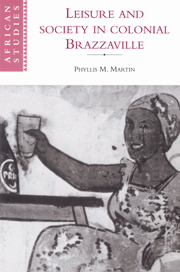Book contents
- Frontmatter
- Contents
- List of plates
- List of maps
- List of tables
- Acknowledgements
- List of abbreviations
- Introduction
- 1 An African crossroads, a frontier post and a colonial town, c. 1880–1915
- 2 Taking hold of the town, c. 1915–1960
- 3 The emergence of leisure
- 4 Football is king
- 5 About the town
- 6 Dressing well
- 7 High society
- Conclusion
- Notes
- Bibliography
- Index
- Titles in the series
2 - Taking hold of the town, c. 1915–1960
Published online by Cambridge University Press: 09 November 2009
- Frontmatter
- Contents
- List of plates
- List of maps
- List of tables
- Acknowledgements
- List of abbreviations
- Introduction
- 1 An African crossroads, a frontier post and a colonial town, c. 1880–1915
- 2 Taking hold of the town, c. 1915–1960
- 3 The emergence of leisure
- 4 Football is king
- 5 About the town
- 6 Dressing well
- 7 High society
- Conclusion
- Notes
- Bibliography
- Index
- Titles in the series
Summary
Brazzaville's development as a thriving colonial capital was long delayed. Equatorial Africa remained near the bottom of France's colonial priorities until 1940 when General de Gaulle, casting about for a piece of French soil to legitimize the existence of Free France, found it on the banks of the Congo river. Communications with the global economy were improved with the opening of the Congo-Ocean railway linking Brazzaville to Pointe-Noire in 1934. The actual construction was a severe drain on AEF's thin population and economic resources. In the years after the Second World War, when Brazzaville received capital for several large construction projects, the town became a magnet for workers and young people from rural areas seeking schooling and employment.
Between the world wars, a permanent town population with a keen awareness of their needs and aspirations came into being. Over the first four decades of the century, the number of immigrants who arrived and stayed increased, although they also maintained strong links with rural areas, particularly those who came from the Pool, Boko and Mindouli regions. Swedish missionary schoolteachers in the late 1930s continued to find that school-children, especially girls, from the Pool and lower Congo districts tended to disappear in the wet season, when they returned to their family land with their mothers to work in farming. Furthermore, the allegiance of the Lari who lived in Brazzaville to André Matswa, a nationalist agitator in the eyes of the French, was sustained in the face of persecution through support from rural chiefs.
- Type
- Chapter
- Information
- Leisure and Society in Colonial Brazzaville , pp. 45 - 70Publisher: Cambridge University PressPrint publication year: 1996

